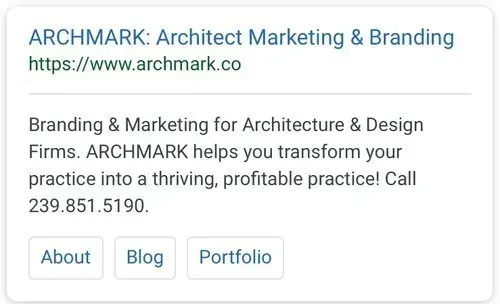SEO Strategy For Architects
5 Ways to Build a Successful SEO Strategy
“50% of searches that people conduct on their mobile phone will result in a visit to a business that same day.”
Are you on the fence about creating a Search Engine Optimization (SEO) strategy for your architecture firm?
You might think that your architecture firm gets 90% of new business from referrals, so why bother with SEO.
That's the kind of thinking that can keep quality referrals from finding you and result in lost opportunities for your firm.
When someone gets a referral for an architecture firm, the first thing they will do is look that firm up online. If they can't find what they're looking for, it can create a negative impression for that prospect.
That's only one reason to have an effective SEO strategy.
Local searches result in phone calls. In fact, 50% of searches that people conduct on their mobile phone will result in a visit to a business that same day.
SEO can enhance your bottom line.
In this article, we share the five key steps for creating an effective SEO strategy to boost your architecture firm’s website traffic.
The Difference Between SEO Strategy & SEO Tactics
A strategy is a broad approach you will take to reach a goal. Tactics are the specific actions you will take to get there.
Begin with the end in mind. In other words, start with your goal, develop an approach (strategy) tailored to your situation, and then determine which tactics are best aligned with the strategy.
For example, your business goal may be positioning your architecture firm as the premier firm in Florida and increasing revenue by 7%.
The corresponding SEO strategy is positioning your company as a thought leader in the field of architecture and ranking in the top three results for the most relevant keywords.
The tactics are designed to support the strategy and goals. Some of the tactics might include interviewing other industry leaders or writing about industry trends — using specific keywords in the content you write for your web page or blog post.
When you write a blog post about these strategic topics, try to to include links to businesses or articles you reference. These are called backlinks. Having links from your page to other websites, and vice versa, is important. Google takes the quantity and quality of backlinks into account as criteria for your search engine results page ranking.
When it comes to page ranking, if your firm is not on the first page of results for a given search term, you're missing out on potential business.
The next step is to reach out to that person or company, and let them know you've mentioned them in your article. Remember—flattery never hurts! Kindly, ask them to post it on their website and social media platforms.
Most people can't say no to free press, so they will usually be happy to promote your article. They might even feel compelled to write something up about you. At the very least, you'll be on their radar.

Drafting Your Strategy
Your strategy starts with the goals of your firm.
You'll want to review your firm's vision and mission because the company's goals should be aligned with these core company principles. It should also be consistent with your architecture firm's brand.
Many organizations start off with goals that seem like a great idea, but they have little to do with the brand, vision, or mission of the company.
It may help to do a mindmap and brainstorm ideas to gain clarity on these topics. This can be done solo or you can involve your entire team.
Your strategy draft will outline the mission, vision, and goals of the company. It also should include a competitive landscape and target market analysis.
Finally, your strategy will include a plan to help you achieve your goals. It's important to note that the key to creating a successful strategy is getting it down on paper. There's no need to overthink it and you don't need to write a dissertation. It can be as simple as one or two lines.
Grab a copy of our free guidebook and start setting S.M.A.R.T. Goals
Perform Keyword Research
Now that you have your SEO strategy, you'll need to research your target market and truly understand who your target audience is.
In this step, you should perform preliminary keyword research. These are keywords and search terms that potential clients will use to find your services.
For example, if you own an architecture firm, you'd want to use terms like 'architect' or 'architect near me'. If you specialize in a particular area, take this into account when selecting keyword terms. For example, if you specialize in commercial architecture, include terms relevant to commercial architecture.
Like we mentioned earlier, local SEO is important. You'll want to make sure you're using words specific to your area. Instead of 'architect near me', you could put 'architect in South Florida'.
In addition to using proper keywords, make sure your business is properly listed online. For our own clients, we list their firms in 70 of the top business listing services including Google My Business, Apple and Google Maps, Facebook, Yahoo, and many others.
Deciding the Best Tactics to Use
Once you have your SEO strategy down, you can outline the tactics that will get you where you want to go. There are many ways that you can improve your SEO rankings.
It's important to choose the tactics that will best support your goals and strategy.
Using the earlier example, if the strategy is to position you as a thought leader and to rank in the top 3 of relevant keywords, here are some tactics you should consider.
Guest Posts: Guest posts can help accomplish both parts of the strategy at once. Through guest posts, you're writing for other outlets, and getting backlinks and exposure in the process.
Interview Influencers: If you already have a running blog, a way to get attention to it is to interview other influencers in the design and architecture world.
Review Current Website Architecture: At the core of SEO is your website. To rank high in search engines, your website needs to be in top shape, using the best practices outlined by Google.
This means it needs to be fast, and responsive. Your pages need to have proper titles and meta descriptions written clearly and using relevant keywords. To refresh your memory, titles are the name of each page on your website, and meta descriptions tell searchers what your page is about.
These are important because it’s what will be displayed on Google. We recommend having a maximum of six words for your title. Meta descriptions should be between 50-300 characters long. Short and concise is the way to go!
You also need a clear hierarchy or structure of pages. This means creating a sitemap to lay out where your web pages will go. After that's done, check each page's URL. You don't want a URL that has random letters and numbers, so make sure to customize them.

The end of your URLs should simply be what the page is, or the title of your article. Instead of using underscores between words in your URLs, use hyphens. Doing this will make them look better to Google's algorithms and makes for better readability and usability.
There are dozens of other tactics you can employ. As you're choosing your tactics, it's important to consider how they'll be executed, when, and by whom.
Having these written down will add accountability to make sure that your team follows through.
Now that you have the overarching strategy and tactics written down, your team can execute the plan.
Review & Revisit Your SEO Strategy
It's important to remember that your SEO strategy isn't a static document collecting dust on your desk. It needs to be reviewed and revised regularly. We recommend reviewing your SEO strategy with your team every six months.
When you implement your strategy and tactics, make sure that you have the appropriate analytics set up to track your success.
Every business should have Google Analytics and Google Search Console set up. Optional tools to add are SE Ranking, SEMrush, or Serpstat, to track your search engine rankings.
Whether you have a short-term or long-term goal, it will determine your strategy and how frequently you review it.
If you discover through this strategy process that your website is severely lacking SEO power, it's better to start from the beginning.
While this probably wasn't the solution you were looking for, it just might be a blessing in disguise. A website relaunch will give you...
- a fresh start on maintaining your website using current best practices
- an up-to-date website with the latest algorithms and trends
- a refreshed excitement about your brand
- an excuse to ask people to visit your website
If you decide to give your website an overhaul, be sure to send a newsletter out to your mailing list. You can also post about it on social media.

Ready to Begin Your SEO Strategy?
Start by Reading our 5 Tips To Improve SEO for Architecture Firms
Even though an SEO strategy is a very brief statement, there is a lot that goes into it. You need to have a deep understanding of your company, your clients, competition, and your goals.
Once you have your strategy, then you can focus on executing the tactics what will help you achieve your goals.
It may seem like a lot of work, but the good news is that you don't have to do this alone. The team at Archmark works with architects and designers to help them grow their business.












